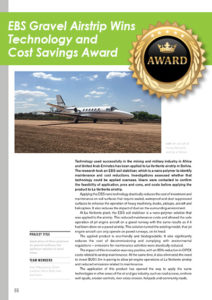In the world of airstrip construction and maintenance, a groundbreaking approach has emerged, leveraging nano polymer technology to transform gravel runways into efficient, durable, and environmentally friendly alternatives to traditional paved surfaces. This article delves into a case study from La Vertiente, Bolivia, where this innovative solution has not only proven its worth but has also set new standards in the industry.
The Challenge: Traditional airstrip construction and maintenance in remote locations face numerous challenges, including high costs, environmental impact, and the need for frequent upkeep. The La Vertiente airstrip in Bolivia required a solution that could withstand the rigors of jet engine aircraft without the hefty price tag and environmental footprint of paving.
Innovative Solution: Enter Engineered Base Stabilizer (EBS), which has been successfully applied in various sectors including mining, construction, tourism, golf, agricultural and military, across Africa and the UAE. This technology offers a sustainable and cost-effective alternative to asphalt, significantly reducing maintenance requirements and operational costs.
Benefits and Impact:
- Cost Efficiency: The application of EBS technology negated the need for a $1.5 million investment in traditional paving, representing an 85% reduction in operational expenses.
- Environmental Sustainability: By avoiding asphalt paving, the project significantly reduced its carbon footprint, aligning with global efforts towards more sustainable infrastructure development.
- Operational Excellence: The enhanced gravel runway can now safely accommodate jet engine aircraft, offering the same level of performance as its paved counterparts and ensuring reliable access to remote areas.
Future Implications: The success of the La Vertiente airstrip project opens a realm of possibilities for airstrip construction worldwide, especially in remote and challenging environments. This technology not only presents a viable alternative to traditional methods but also aligns with environmental sustainability goals.
Conclusion: The case study of La Vertiente’s airstrip in Bolivia is a testament to the potential of EBS in transforming airstrip construction and maintenance. By offering a cost-effective, environmentally friendly, and durable solution, this innovative approach is poised to revolutionize the industry, enhancing connectivity in remote areas and supporting global tourism and economic development.



